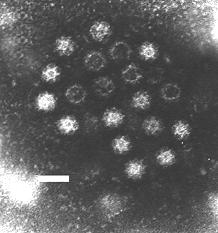
Back فيروسات كأسية Arabic فيروسات كاسيه ARZ Caliciviridae Catalan Caliciviridae German Caliciviridae Spanish ویروس کالیسی Persian Caliciviridae French Caliciviridae Irish Calicivírus Hungarian Caliciviridae Italian
| Caliciviridae | |
|---|---|

| |
| Virus classification | |
| (unranked): | Virus |
| Realm: | Riboviria |
| Kingdom: | Orthornavirae |
| Phylum: | Pisuviricota |
| Class: | Pisoniviricetes |
| Order: | Picornavirales |
| Family: | Caliciviridae |
| Genera | |
|
See text | |
The Caliciviridae are a family of "small round structured" viruses, members of Class IV of the Baltimore scheme. Caliciviridae bear resemblance to enlarged picornavirus and was formerly a separate genus within the picornaviridae.[1] They are positive-sense, single-stranded RNA which is not segmented.[2] Thirteen species are placed in this family, divided among eleven genera.[3] Diseases associated with this family include feline calicivirus (respiratory disease), rabbit hemorrhagic disease virus (often fatal hepatitis), and Norwalk group of viruses (gastroenteritis).[3][4] Caliciviruses naturally infect vertebrates, and have been found in a number of organisms such as humans, cattle, pigs, cats, chickens, reptiles, dolphins and amphibians. The caliciviruses have a simple construction and are not enveloped. The capsid appears hexagonal/spherical and has icosahedral symmetry (T=1[5] or T=3[6][4]) with a diameter of 35–39 nm.[7]
Caliciviruses are not very well studied because until recently, they could not be grown in culture, and they have a very narrow host range and no suitable animal model. However, the recent application of modern genomic technologies has led to an increased understanding of the virus family.[7] A recent isolate from rhesus monkeys—Tulane virus—can be grown in culture, and this system promises to increase understanding of these viruses.[8]
- ^ "Caliciviridae - Caliciviridae - Positive-sense RNA Viruses - ICTV". talk.ictvonline.org. Retrieved 12 March 2021.
- ^ Vinjé, J; Estes, MK; Esteves, P; Green, KY; Katayama, K; Knowles, NJ; L'Homme, Y; Martella, V; Vennema, H; White, PA; ICTV Report Consortium (November 2019). "ICTV Virus Taxonomy Profile: Caliciviridae". The Journal of General Virology. 100 (11): 1469–1470. doi:10.1099/jgv.0.001332. PMC 7011698. PMID 31573467.
- ^ a b "ICTV Report Caliciviridae".
- ^ a b "Viral Zone". ExPASy. Retrieved 15 June 2015.
- ^ T=1
- ^ T=3
- ^ a b Hansman, GS, ed. (2010). Caliciviruses: Molecular and Cellular Virology. Caister Academic Press. ISBN 978-1-904455-63-9.
- ^ Yu G, Zhang D, Guo F, Tan M, Jiang X, Jiang W (2013). "Cryo-EM structure of a novel calicivirus, Tulane Virus". PLoS One 8(3):e59817. doi:10.1371/journal.pone.0059817